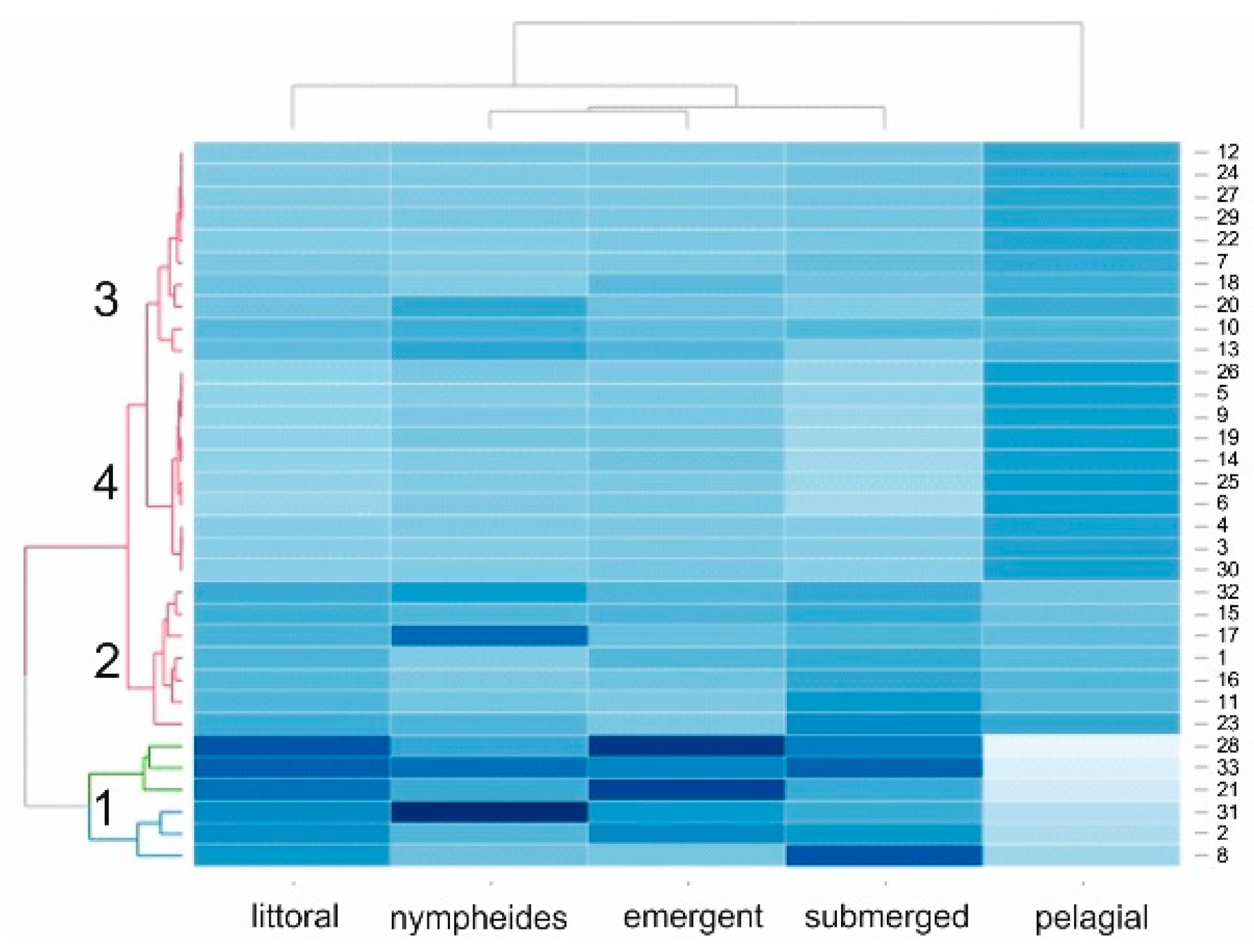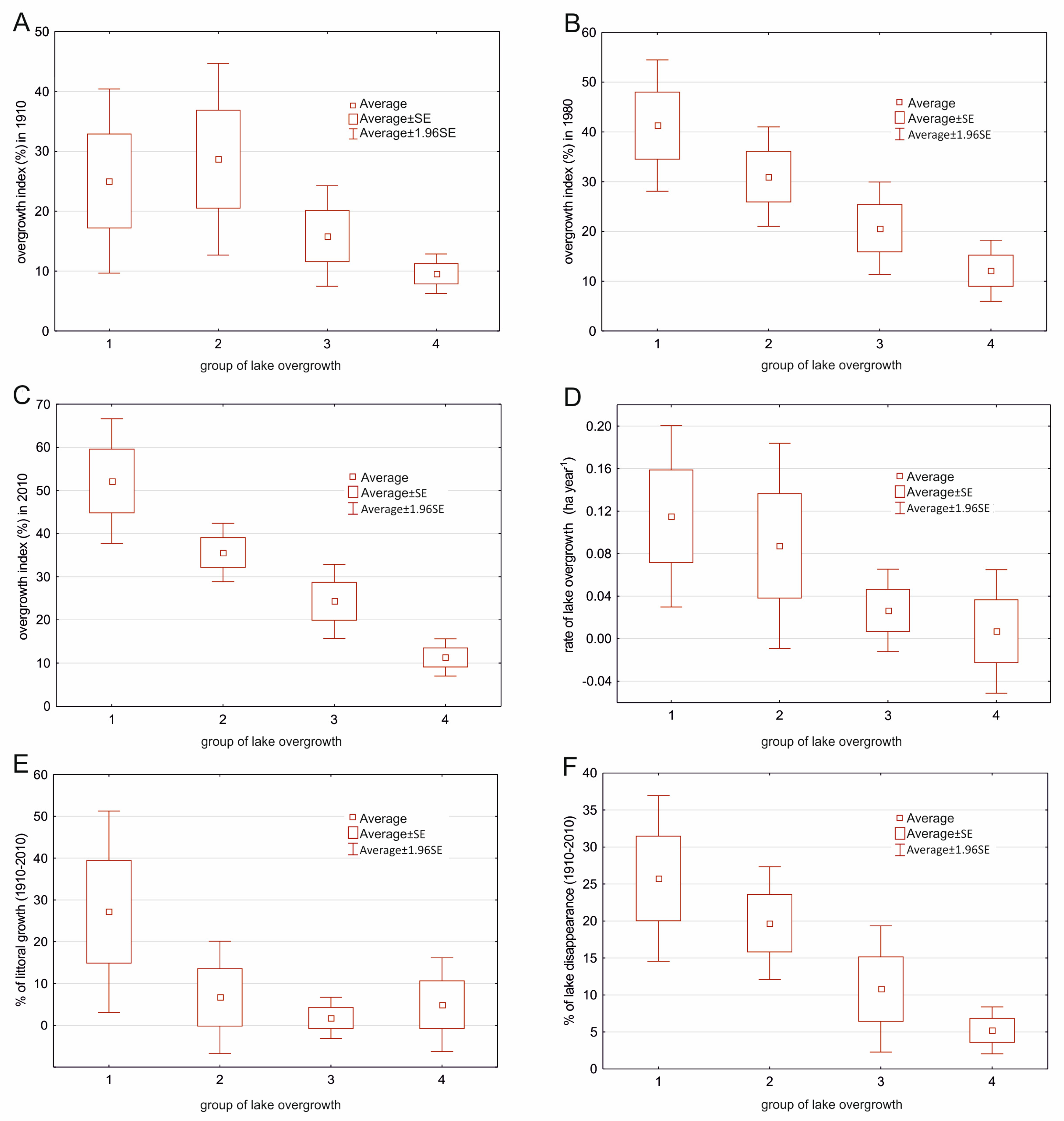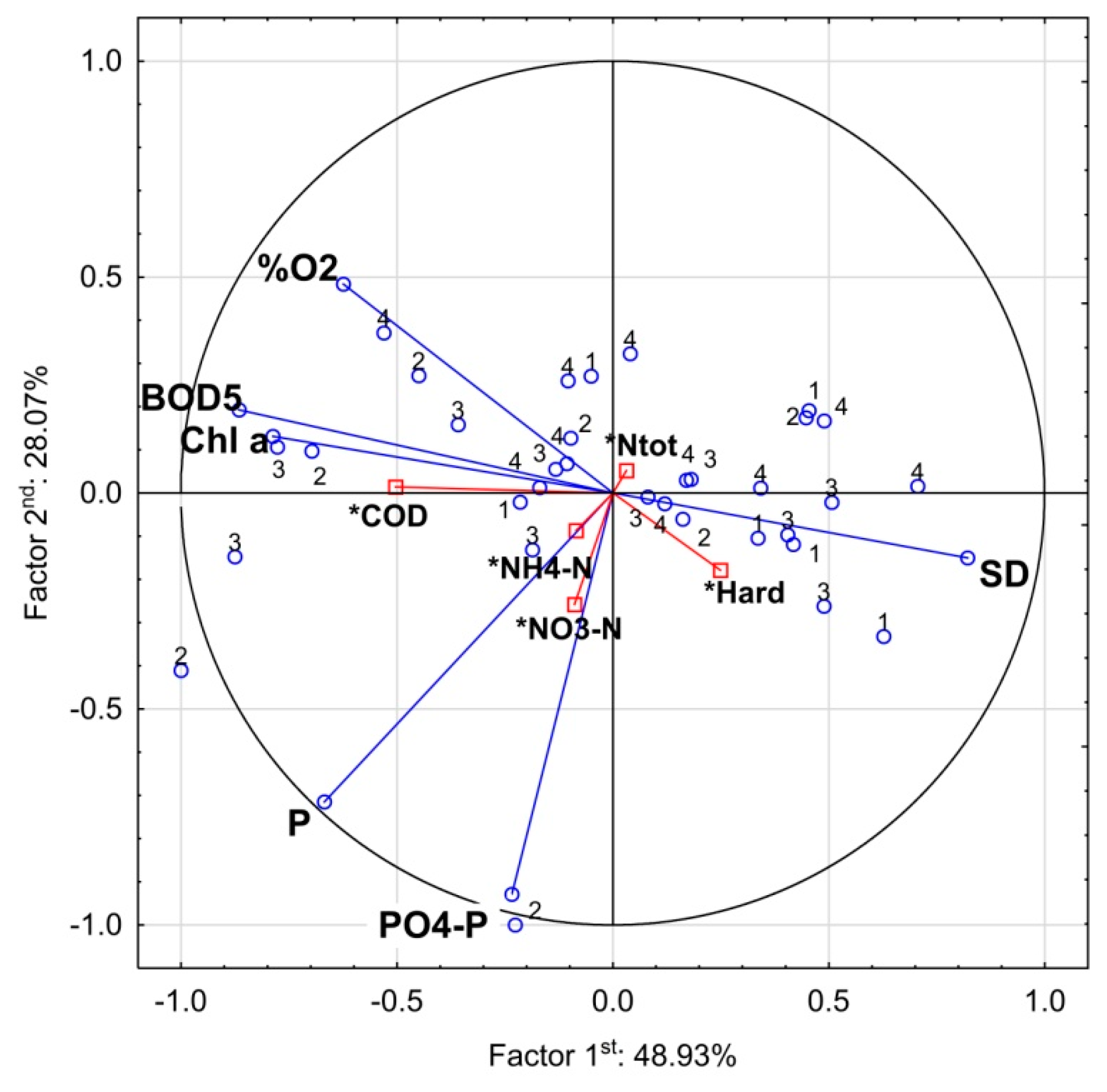Indicator Values of Emergent Vegetation in Overgrowing Lakes in Relation to Water and Sediment Chemistry
Abstract
:1. Introduction
- (1)
- A high proportion of emerged macrophytes in lake indicates the intensity of the lake overgrowth process without the need to take into account the participation of other forms of macrophytes, especially those submerged;
- (2)
- Heavily overgrown lakes are characterized by intensive development of the helophyte zone observed in the multiyear scale;
- (3)
- Eutrophic, strongly overgrown lakes are characterized by better water quality determined by higher levels of macrophytes compared lakes with low overgrowth rates, at the same time with high content of nutrients in bottom sediments.
2. Materials and Methods
2.1. Macrophytes
2.2. Cartographic Analyses
2.3. Water Samples
2.4. Sediment
2.5. Statistics
3. Results
3.1. Degree of Lake Overgrowth
3.2. Rate of Lake Disappearances and Overgrowth on the Basis of Maps
3.3. Trophies of Lakes According to Physicochemical Parameters of Waters and Sediments
4. Discussion
4.1. Relationship between Macrophyte Forms in Overgrowing Lakes
4.2. Cartographic Analyses in Lake Overgrowth
4.3. Trophy of Overgrowing Lakes
5. Conclusions
Supplementary Materials
Acknowledgments
Author Contributions
Conflicts of Interest
References
- Phillips, G.; Willby, N.; Moss, B. Submerged macrophyte decline in shallow lakes: What have we learnt in the last forty years? Aquat. Bot. 2016, 135, 37–45. [Google Scholar] [CrossRef]
- Hilt, S.; Gross, E.M.; Hupfer, M.; Morscheid, H.; Mählmann, J.; Melzer, A.; Poltz, J.; Sandrock, S.; Scharf, E.M.; Schneider, S.; et al. Restoration of submerged vegetation in shallow eutrophic lakes—A guideline and state of the art in Germany. Limnologica 2006, 36, 155–171. [Google Scholar] [CrossRef]
- Jeppesen, E.; Peder Jensen, J.; Søndergaard, M.; Lauridsen, T.; Junge Pedersen, L.; Jensen, L. Top-down control in freshwater lakes: The role of nutrient state, submerged macrophytes and water depth. Hydrobiologia 1997, 342, 151–164. [Google Scholar] [CrossRef]
- Kolada, A. The use of helophytes in assessing eutrophication of temperate lowland lakes: Added value? Aquat. Bot. 2016, 129, 44–54. [Google Scholar] [CrossRef]
- Ławniczak, A. The role of emergent macrophytes in nutrient cycling in Lake Niepruszewskie (western Poland). Oceanol. Hydrobiol. Stud. 2010, 39, 75–83. [Google Scholar] [CrossRef]
- Ciecierska, H. Macrophyte Based Indices of the Ecological State of Lakes. Ph.D. Thesis, University of Warmia and Mazury, Olsztyn, Poland, 2008. [Google Scholar]
- Liira, J.; Feldmann, T.; Mäemets, H.; Peterson, U. Two decades of macrophyte expansion on the shores of a large shallow northern temperate lake-A retrospective series of satellite images. Aquat. Bot. 2010, 93, 207–215. [Google Scholar] [CrossRef]
- Andersson, B. Macrophyte Development and Habitat Characteristics in Sweden’s Large Lakes. AMBIO J. Hum. Environ. 2001, 30, 503–513. [Google Scholar] [CrossRef]
- Partanen, S.; Luoto, M. Environmental determinants of littoral paludification in boreal lakes. Limnologica 2006, 36, 98–109. [Google Scholar] [CrossRef]
- Ławniczak, A. Overgrowing of two polymictic lakes in Central-Western Poland. Limnol. Rev. 2010, 10, 147–156. [Google Scholar] [CrossRef]
- Ławniczak, A.E.; Choiński, A.; Kurzyca, I. Dynamics of lake morphometry and bathymetry in various hydrological conditions. Pol. J. Environ. Stud. 2011, 20, 931–940. [Google Scholar]
- Mohamed, Z.A. Macrophytes-cyanobacteria allelopathic interactions and their implications for water resources management—A review. Limnologica 2017, 63, 122–132. [Google Scholar] [CrossRef]
- Lewin, I.; Jusik, S.; Szoszkiewicz, K.; Czerniawska-Kusza, I.; Ławniczak, A.E. Application of the new multimetric MMI_PL index for biological water quality assessment in reference and human-impacted streams (Poland, the Slovak Republic). Limnologica 2014, 49, 42–51. [Google Scholar] [CrossRef]
- Ciecierska, H.; Kolada, A. ESMI: A macrophyte index for assessing the ecological status of lakes. Environ. Monit. Assess. 2014, 186, 5501–5517. [Google Scholar] [CrossRef] [PubMed]
- Official Journal of the European Communities. Directive 2000/60/EC of the European Parliament and of the Council of 23 Oct. 2000 Establishing a Frame-work for Community Action in the Field of Water Policy. Off. J. Eur. Commun. 2000, 72. [Google Scholar] [CrossRef]
- Scheffer, M.; Hosper, S.; Meijer, M.; Moss, B.; Jeppesen, E. Alternative equilibria in shalow lakes. Trends Ecol. Evol. 1993, 8, 275–279. [Google Scholar] [CrossRef]
- Baastrup-Spohr, L.; Sand-Jensen, K.; Olesen, S.C.H.; Bruun, H.H. Recovery of lake vegetation following reduced eutrophication and acidification. Freshw. Biol. 2017, 62, 1847–1857. [Google Scholar] [CrossRef]
- Sand-Jensen, K.; Bruun, H.H.; Baastrup-Spohr, L. Decade-long time delays in nutrient and plant species dynamics during eutrophication and re-oligotrophication of Lake Fure 1900–2015. J. Ecol. 2017, 105, 690–700. [Google Scholar] [CrossRef]
- Vilas, M.P.; Marti, C.L.; Adams, M.P.; Oldham, C.E.; Hipsey, M.R. Invasive macrophytes control the spatial and temporal patterns of temperature and dissolved oxygen in a shallow lake: A proposed feedback mechanism of macrophyte loss. Front. Plant Sci. 2017, 8, 1–14. [Google Scholar] [CrossRef] [PubMed]
- Schutten, J.; van der Velden, J.A.; Smit, H. Submerged macrophytes in the recently freshened lake system Volkerak-Zoom (The Netherlands), 1987–1991. Hydrobiologia 1994, 275, 207–218. [Google Scholar] [CrossRef]
- Silva, T.S.F.; Costa, M.P.F.; Melack, J.M.; Novo, E.M.L.M. Remote sensing of aquatic vegetation: Theory and applications. Environ. Monit. Assess. 2008, 140, 131–145. [Google Scholar] [CrossRef] [PubMed]
- Han, X.; Feng, L.; Hu, C.; Chen, X. Wetland changes of China’s largest freshwater lake and their linkage with the Three Gorges Dam. Remote Sens. Environ. 2018, 204, 799–811. [Google Scholar] [CrossRef]
- Zhang, Y.; Jeppesen, E.; Liu, X.; Qin, B.; Shi, K.; Zhou, Y.; Thomaz, S.M.; Deng, J. Global loss of aquatic vegetation in lakes. Earth-Sci. Rev. 2017, 173, 259–265. [Google Scholar] [CrossRef]
- Lawniczak, A.E.; Zbierska, J.; Nowak, B.; Achtenberg, K.; Grześkowiak, A.; Kanas, K. Impact of agriculture and land use on nitrate contamination in groundwater and running waters in central-west Poland. Environ. Monit. Assess. 2016, 188, 172. [Google Scholar] [CrossRef] [PubMed]
- Kupiec, J.; Zbierska, J. Comparison of results obtained from different types of nitrogen balance in the scale of a field and a farm. Pol. J. Environ. Stud. 2012, 21, 1295–1304. [Google Scholar]
- Braun-Blanquet, J. Pflanzensoziologie: Grundzüge der Vegetationskunde; Springer: New York, NY, USA, 1964. [Google Scholar]
- Matuszkiewicz, W. A Guide Book to Identification Plant Communities in Poland; Państwowe Wydawnictwo Naukowe: Warszawa, Poland, 2002. [Google Scholar]
- Jankowska, M. Okoliczności powstania i sposób opracowania pruskiej mapy topograficznej z I polowy XIX wieku w skali 1:25 000. Roczniki Akademii Rolniczej w Poznaniu. Melioracje i Inżynieria Środowiska 1993, 11, 37–45. [Google Scholar]
- Graf, R.; Kaniecki, A.; Medyńska-Gulij, B. Dawne mapy jako źródło informacji o wodach śródlądowych i stopniu ich antropogenicznych przeobrażeń. Fizjograficzne, Badania nad Polską Zachodnią, Seria-A-Geografia Fizyczna 2008, 59, 11–27. [Google Scholar]
- Elbanowska, H.; Zerbe, J.; Siepak, J. Physicochemical Analyses of Water; Państwowe Wydawnictwo Naukowe: Poznań, Poland, 1999. [Google Scholar]
- Carlson, R.E. A trophic state index for lakes. Limnol. Oceanogr. 1977, 22, 361–369. [Google Scholar] [CrossRef]
- Alahuhta, J. Geographic patterns of lake macrophyte communities and species richness at regional scale. J. Veg. Sci. 2015, 26, 564–575. [Google Scholar] [CrossRef]
- Søndergaard, M.; Johansson, L.S.; Lauridsen, T.L.; Jørgensen, T.B.; Liboriussen, L.; Jeppesen, E. Submerged macrophytes as indicators of the ecological quality of lakes. Freshw. Biol. 2010, 55, 893–908. [Google Scholar] [CrossRef]
- Moss, B.; Jeppesen, E.; Søndergaard, M.; Lauridsen, T.L.; Liu, Z. Nitrogen, macrophytes, shallow lakes and nutrient limitation: Resolution of a current controversy? Hydrobiologia 2013, 710, 3–21. [Google Scholar] [CrossRef]
- Tylová, E.; Steinbachová, L.; Votrubová, O.; Gloser, V. Phenology and autumnal accumulation of N reserves in belowground organs of wetland helophytes Phragmites australis and Glyceria maxima affected by nutrient surplus. Environ. Exp. Bot. 2008, 63, 28–38. [Google Scholar] [CrossRef]
- Steinbachová-Vojtíšková, L.; Tylová, E.; Soukup, A.; Novická, H.; Votrubová, O.; Lipavská, H.; Čížková, H. Influence of nutrient supply on growth, carbohydrate, and nitrogen metabolic relations in Typha angustifolia. Environ. Exp. Bot. 2006, 57, 246–257. [Google Scholar] [CrossRef]
- Tylova-Munzarova, E.; Lorenzen, B.; Brix, H.; Votrubova, O. The effects of NH4+ and NO3− on growth, resource allocation and nitrogen uptake kinetics of Phragmites australis and Glyceria maxima. Aquat. Bot. 2005, 81, 326–342. [Google Scholar] [CrossRef]
- Marion, L.; Paillisson, J. A mass balance assessment of the contribution of floating-leaved macrophytes in nutrient stocks in an eutrophic macrophyte-dominated lake. Aquat. Bot. 2003, 75, 249–260. [Google Scholar] [CrossRef]
- Bornette, G.; Puijalon, S. Response of aquatic plants to abiotic factors: A review. Aquat. Sci. 2011, 73, 1–14. [Google Scholar] [CrossRef]
- Alahuhta, J.; Kanninen, A.; Hellsten, S.; Vuori, K.M.; Kuoppala, M.; Hämäläinen, H. Variable response of functional macrophyte groups to lake characteristics, land use, and space: Implications for bioassessment. Hydrobiologia 2014, 737, 201–214. [Google Scholar] [CrossRef]
- Choiński, A.; Ptak, M.; Ławniczak, A.E. Changes in water resources of Polish lakes as influenced by natural and anthropogenic factors. Pol. J. Environ. Stud. 2016, 25, 1883–1890. [Google Scholar] [CrossRef]
- Crisman, T.L.; Mitraki, C.; Zalidis, G. Integrating vertical and horizontal approaches for management of shallow lakes and wetlands. Ecol. Eng. 2005, 24, 379–389. [Google Scholar] [CrossRef]
- Kolada, A. The effect of lake morphology on aquatic vegetation development and changes under the influence of eutrophication. Ecol. Indic. 2014, 38, 282–293. [Google Scholar] [CrossRef]
- Lawniczak, A.E.; Zbierska, J.; Choiński, A.; Szczepaniak, W. Response of emergent macrophytes to hydrological changes in a shallow lake, with special reference to nutrient cycling. Hydrobiologia 2010, 656, 243–254. [Google Scholar] [CrossRef]
- Fritz, C.; Schneider, T.; Geist, J. Seasonal variation in spectral response of submerged aquatic macrophytes: A case study at lake Starnberg (Germany). Water 2017, 9, 527. [Google Scholar] [CrossRef]
- Luo, J.; Ma, R.; Duan, H.; Hu, W.; Zhu, J.; Huang, W.; Lin, C. A new method for modifying thresholds in the classification of tree models for mapping aquatic vegetation in taihu lake with satellite images. Remote Sens. 2014, 6, 7442–7462. [Google Scholar] [CrossRef]
- Fritz, C.; Dörnhöfer, K.; Schneider, T.; Geist, J.; Oppelt, N. Mapping submerged aquatic vegetation using RapidEye satellite data: The example of Lake Kummerow (Germany). Water 2017, 9, 510. [Google Scholar] [CrossRef]
- Portielje, R.; Van der Molen, D.T. Relationships between eutrophication variables: From nutrient loading to transparency. Hydrobiologia 1999, 409, 375–387. [Google Scholar] [CrossRef]
- Bakker, E.S.; Sarneel, J.M.; Gulati, R.D.; Liu, Z.; van Donk, E. Restoring macrophyte diversity in shallow temperate lakes: Biotic versus abiotic constraints. Hydrobiologia 2013, 710, 23–37. [Google Scholar] [CrossRef]
- Sondergaard, M.; Moss, B. Impact of submerged macrophytes on phytoplankton in shallow freshwater lakes. In The Structuring Role of Submerged Macrophytes in Lakes. Ecological Studies (Analysis and Synthesis); Jeppesen, E., Søndergaard, M., Søndergaard, M., Christofferson, K., Eds.; Springer: New York, NY, USA, 1998; Volume 131, pp. 115–132. [Google Scholar]
- Mi, W.J.; Zhu, D.W.; Zhou, Y.Y.; Zhou, H.D.; Yang, T.W.; Hamilton, D.P. Influence of Potamogeton crispus growth on nutrients in the sediment and water of Lake Tangxunhu. Hydrobiologia 2008, 603, 139–146. [Google Scholar] [CrossRef] [Green Version]
- Boros, G.; Søndergaard, M.; Takács, P.; Vári, Á.; Tátrai, I. Influence of submerged macrophytes, temperature, and nutrient loading on the development of redox potential around the sediment-water interface in lakes. Hydrobiologia 2011, 665, 117–127. [Google Scholar] [CrossRef]
- Hilt, S.; Köhler, J.; Adrian, R.; Monaghan, M.T.; Sayer, C.D. Clear, crashing, turbid and back long-term changes in macrophyte assemblages in a shallow lake. Freshw. Biol. 2013, 58, 2027–2036. [Google Scholar] [CrossRef]
- Søndergaard, M.; Lauridsen, T.L.; Johansson, L.S.; Jeppesen, E. Nitrogen or phosphorus limitation in lakes and its impact on phytoplankton biomass and submerged macrophyte cover. Hydrobiologia 2017, 795, 35–48. [Google Scholar] [CrossRef]
- Lawniczak, A.E. Nitrogen, phosphorus, and potassium resorption efficiency and proficiency of four emergent macrophytes from Nutrient-Rich Wetlands. Pol. J. Environ. Stud. 2011, 20, 1227–1234. [Google Scholar]
- Lawniczak, A.E.; Güsewell, S.; Verhoeven, J.T.A. Effect of N:K supply ratios on the performance of three grass species from herbaceous wetlands. Basic Appl. Ecol. 2009, 10, 715–725. [Google Scholar] [CrossRef]
- Vitousek, P.M.; Howarth, R.W. Nitrogen Limitation on Land and in the Sea: How Can It Occur? Biogeochemistry 2007, 13, 87–115. [Google Scholar] [CrossRef]
- Krolová, M.; Čížková, H.; Hejzlar, J. Depth limit of littoral vegetation in a storage reservoir: A case study of Lipno Reservoir (Czech Republic). Limnologica 2012, 42, 165–174. [Google Scholar] [CrossRef]
- Jeppesen, E.; Brucet, S.; Naselli-Flores, L.; Papastergiadou, E.; Stefanidis, K.; Nõges, T.; Nõges, P.; Attayde, J.L.; Zohary, T.; Coppens, J.; et al. Ecological impacts of global warming and water abstraction on lakes and reservoirs due to changes in water level and related changes in salinity. Hydrobiologia 2015, 750, 201–227. [Google Scholar] [CrossRef]
- Stefanidis, K.; Kostara, A.; Papastergiadou, E. Implications of Human Activities, Land Use Changes and Climate Variability in Mediterranean Lakes of Greece. Water 2016, 8, 483. [Google Scholar] [CrossRef]






| Parameter | df | F | p |
|---|---|---|---|
| Overgrowth index in 1910 (%) | 3 | 1.99 | ns |
| Overgrowth index in 1980 (%) | 3 | 7.04 | ** |
| Overgrowth index in 2010 (%) | 3 | 13.82 | *** |
| Rate of lake overgrowth (1910–2010) (ha year−1) | 3 | 4.33 | * |
| Rate of lake overgrowth (1910–1980) (ha year−1) | 3 | 2.25 | ns |
| % of littoral growth (1910–2010) | 3 | 2.53 | ns |
| % of littoral growth (1980–2010) | 3 | 2.89 | ns |
| % of lake disappearance (1910–2011) | 3 | 5.49 | ** |
| Parameter | Littoral | Nympheides | Emerged | Submerged | Pelagial |
|---|---|---|---|---|---|
| Overgrowth index in 2010 (%) | 0.76 *** | 0.50 ** | 0.77 *** | 0.37 ** | −0.73 *** |
| Overgrowth index in 1980 (%) | 0.68 *** | 0.39 | 0.73 *** | 0.19 | −0.63 *** |
| Overgrowth index in 1910 (%) | 0.49 | 0.49 | 0.51 | 0.25 | −0.39 |
| Rate of lake overgrowth (1910–2010) (ha year−1) | 0.34 | 0.14 | 0.39 * | 0.08 | −0.29 |
| Rate of lake overgrowth (1910–1980) (ha year−1) | 0.28 | 0.03 | 0.38 * | 0.02 | −0.23 |
| % of littoral growth (1910–2010) | 0.36 * | 0.08 | 0.39 * | 0.18 | −0.33 |
| % of littoral growth (1980–2010) | 0.47 * | 0.40* | 0.38 * | 0.52* | −0.52 * |
| % of lake disappearance (1910–2010) | 0.50 ** | 0.27 | 0.58 *** | 0.11 | −0.45 ** |
| Group | TSI(Chl) | TSI(TP) | TSI(SD) | TSI |
|---|---|---|---|---|
| 1 | 46.68 ± 8.45 | 73.79 ± 9.31 | 53.91 ± 10.92 | 58.13 ± 7.91 |
| 2 | 59.96 ± 14.81 | 81.55 ± 14.19 | 66.00 ± 8.53 | 69.17 ± 11.72 |
| 3 | 60.51 ± 15.15 | 80.02 ± 5.86 | 66.47 ± 15.94 | 69.00 ± 11.44 |
| 4 | 59.15 ± 14.27 | 71.25 ± 8.69 | 61.10 ± 10.12 | 63.84 ± 9.74 |
| Group | pH | Conductivity | Nitrogen | Potassium | Phosphorus |
|---|---|---|---|---|---|
| µS∙cm−1 | mgN·100 g−1 sed. | mgK·100 g−1 sed. | mgP·100g−1 sed. | ||
| 1 | 6.99 ± 0.09 | 1257 ± 221 | 10.67 ± 3.3 | 9.32 ± 4.29 | 1.65 ± 0.67 |
| 2 | 7.30 ± 0.41 | 831 ± 405 | 7.45 ± 2.65 | 6.92 ± 3.59 | 2.67 ± 1.66 |
| 3 | 7.33 ± 0.41 | 864 ± 425 | 6.41 ± 3.32 | 6.11 ± 4.23 | 2.33 ± 0.89 |
| 4 | 7.53 ± 0.46 | 545 ± 324 | 3.28 ± 2.45 | 3.41 ± 2.26 | 1.62 ± 0.84 |
© 2018 by the authors. Licensee MDPI, Basel, Switzerland. This article is an open access article distributed under the terms and conditions of the Creative Commons Attribution (CC BY) license (http://creativecommons.org/licenses/by/4.0/).
Share and Cite
Lawniczak-Malińska, A.E.; Achtenberg, K. Indicator Values of Emergent Vegetation in Overgrowing Lakes in Relation to Water and Sediment Chemistry. Water 2018, 10, 498. https://doi.org/10.3390/w10040498
Lawniczak-Malińska AE, Achtenberg K. Indicator Values of Emergent Vegetation in Overgrowing Lakes in Relation to Water and Sediment Chemistry. Water. 2018; 10(4):498. https://doi.org/10.3390/w10040498
Chicago/Turabian StyleLawniczak-Malińska, Agnieszka E., and Krzysztof Achtenberg. 2018. "Indicator Values of Emergent Vegetation in Overgrowing Lakes in Relation to Water and Sediment Chemistry" Water 10, no. 4: 498. https://doi.org/10.3390/w10040498
APA StyleLawniczak-Malińska, A. E., & Achtenberg, K. (2018). Indicator Values of Emergent Vegetation in Overgrowing Lakes in Relation to Water and Sediment Chemistry. Water, 10(4), 498. https://doi.org/10.3390/w10040498





